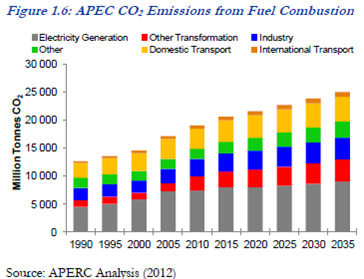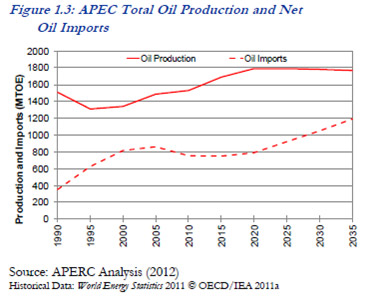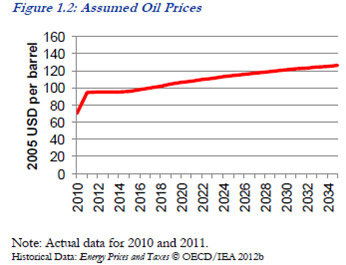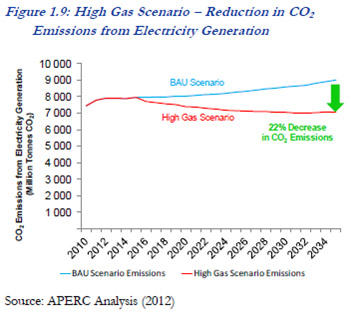In 2011, the Asia-Pacific Energy Cooperation (APEC) Leaders set a target to reduce the region's energy intensity--calculated by dividing energy demand by GDP--by a minimum of 45 percent come 2035.
While this is commendable, a new report suggests that the expected improvement in energy intensity will not be sufficient to put the APEC region on a path toward environmental sustainability. In fact, this path will still result in "disastrous climate change consequences" for the APEC region, which is made up of 21 Pacific Rim economies. These economies account for 40 percent of the world's population (at 2.7 billion people) and about 60 percent of global energy demand.
Published in February 2013 by the Asia Pacific Energy Research Centre (APERC), the APEC Energy Demand and Supply Outlook 5th Edition notes that APEC countries are likely to continue being successful in their goal to reduce primary energy intensity, with the aid of technological advances and government policies that promote energy efficiency, particularly in the power generation sector.
The report, which provides detailed projections of APEC's energy demand, supply, and greenhouse gas emissions to the year 2035, notes that in a business-as-usual scenario, GDP would go up by about 225 percent between 2005 and 2035. However, with project energy intensity improvements, primary energy consumption would expand by only about 53 percent.

Yet this scenario is still not enough to protect the environment. The report estimates that by 2035, over four-fifths of APEC's energy demand will be met by fossil fuels. The fuel combustion from the region will lead to an increase in carbon dioxide emissions of about 46 percent.

This scenario would also leave the APEC region open to threats of energy security. Historically, the APEC region's oil demand has exceeded that of its supply, creating an increase of oil imports to the region. This trend is likely to persist, with oil imports estimated to grow by 55 percent.

Oil price volatility will very likely be present in future along with the serious risk of supply disruptions. These two possible outcomes will threaten the economic stability of not only the APEC region, but also the rest of the world.
The report mentions a few solutions that could counter these effects. The APEC countries will need to allocate more resources to educate people about climate change. These efforts should also help to promote the benefits and importance of energy efficiency. More research can be done on low-carbon energy technologies and governments can explore taxing companies and industries with high greenhouse gas emissions.

An alternative idea includes the "High Gas Scenario". Production of natural gas could be increased by 30 percent if barriers to gas development and trade are reduced. With new technology for shale gas and unconventional gases, these levels of production are even more promising. Carbon dioxide emissions from electricity generation could be reduced by 22 percent in 2035 if these gases were used to replace coal in energy generation, says the report.
Published in February 2013 by the Asia Pacific Energy Research Centre (APERC), the APEC Energy Demand and Supply Outlook 5th Edition aims to provide a basic point of reference for anyone wishing to understand the energy trends and issues facing the APEC region to the year 2035.